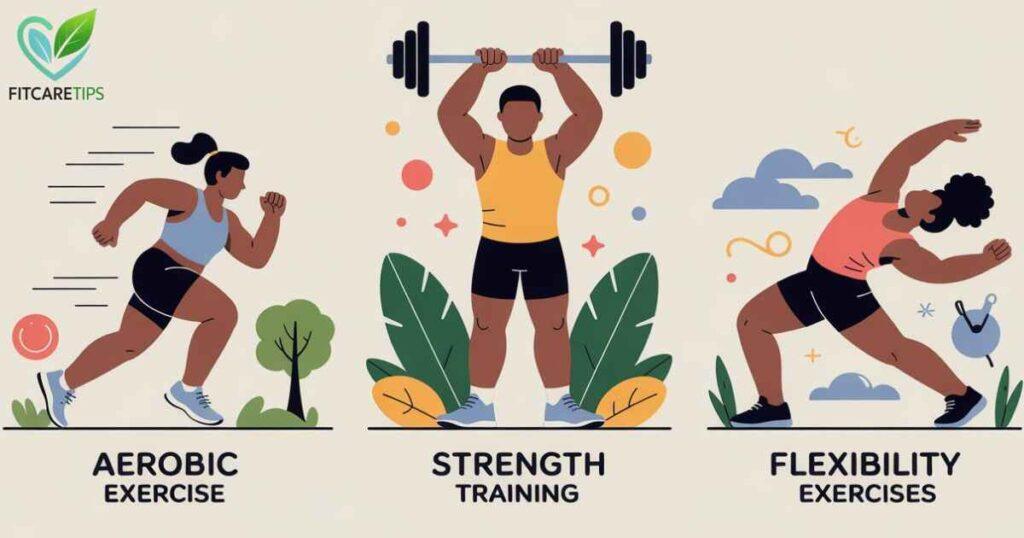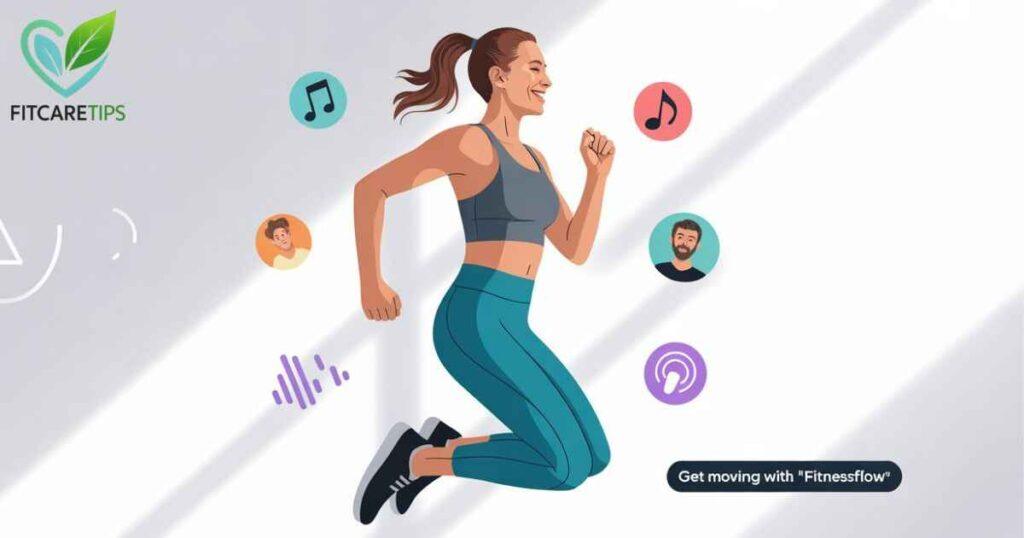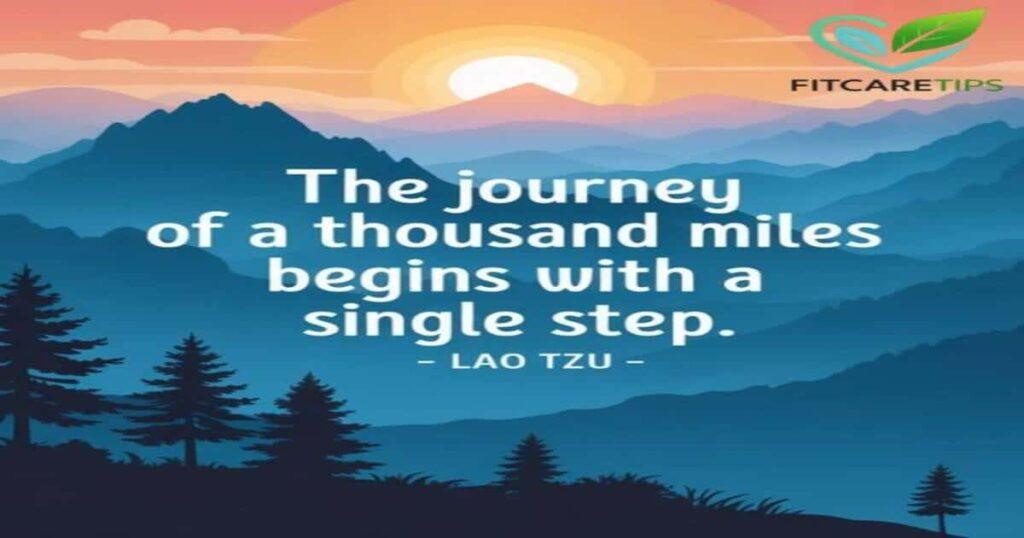Getting started with fitness can be daunting, but it’s within everyone’s reach to go from couch to conditioned. With straightforward, achievable steps centered around behavior modification, balanced eating, and ongoing movement, you can gain strength and enhance well-being at your own speed.
It’s not about a crash program but creating sustainable habits that work within your life. Blending aerobic, strength training, and flexibility will give you more energy and self-assurance.
This book will give you the power to take charge of your wellbeing and demonstrate that regardless of where you are, getting fit and healthy is possible — one tiny step at a time. This beginner fitness guide covers easy workouts, smart nutrition tips, and motivation hacks to help you stay consistent.
The 3 Types of Exercise You Need
To become fit, you require three kinds of exercise: aerobic exercise, strength training, and flexibility. Each serves your body in a different manner. Aerobic exercise such as walking, running, or cycling strengthens your heart and burns calories. Strength training constructs lean muscles that increase your metabolism.
Flexibility exercises such as stretching maintain your joints’ health and prevent injuries. These three pillars form the core of any beginner fitness guide.

Together, all three enable you to be really conditioned. Beginners should begin slowly with easy exercises such as bodyweight squats or slow stretches. Gradually incorporate more muscle-building activity and aerobic work. Adequate portion control and nutrition enable your workouts by providing energy for your body and facilitating recovery. If you concentrate exclusively on one form of exercise, your progress will come more slowly and be less well-rounded.
Picking the Right Exercise for You
The ideal exercise is the one you will perform on a regular basis. If your life is hectic, short bursts such as HIIT or brief bodyweight exercises may be ideal. These exercises may only take 10 to 20 minutes and be extremely effective. If you like the outdoors, biking or hiking is a great option. The principle is to be consistent and pick activities that appeal to you.
Having clear goals also helps. If you want to lose weight, gain muscle, or simply get healthier, having a goal keeps you going. Monitoring progress without fixation on the scale enables you to notice progress. Employing such techniques as temptation bundling, where you pair exercise with something enjoyable like music or listening to podcasts, can make exercising easier and more pleasant.For more details, check out our easy workouts section in this beginner fitness guide.
Quick Workouts That Really Work
You don’t have to spend hours at the gym to become fit. Even those with busy lifestyles can appreciate short but intense training. One of the best means of burning calories quickly is through high-intensity interval training (HIIT). These exercises switch between brief periods of exertion and rest. For instance, you can jump jacks for 30 seconds, rest for 20 seconds, and repeat.
Short workouts are useful in forming lasting habits since they do not feel overwhelming. Performing small, regular bouts of exercise is better than doing nothing at all. The key is getting your body moving regularly, even if it’s only for a few minutes each day.Short sessions are perfect for anyone starting their beginner fitness journey.
How to Exercise at Home or Small Spaces
Numerous people believe that you require a gym to become fit, which is not the case. You can train at home with or without equipment. Water bottles or backpacks around the house can be used as weights. Resistance bands are inexpensive and adaptable tools that will find room in every home.

Bodyweight movements such as push-ups, lunges and planks strengthen muscles without the use of machines. Home workout makes it easy to incorporate fitness into your lifestyle. And coupling this with portion control and healthy eating accelerates the loss of fat and gain of muscle. It is all about developing a routine that suits your lifestyle and space.This shows that fitness for beginners can be simple and achievable at home.
Strength Training That’s Easy for Beginners
Strength training is essential to develop muscle and lose fat. Beginners should pay attention to basic moves such as squats, push-ups, and rows. They work your own weight and teach you the proper way of moving. Proper movement prevents injury and maximizes workout results.
Consuming sufficient protein supports muscle recovery and building strength. Don’t expect progress to be swift, so take your time. Consistency trumps intensity when starting out. With time, your muscles will be stronger, and you will be healthier.In this beginner fitness guide, strength training is highlighted as a key step toward lasting progress.
Smart Training: Sets, Reps, and Rest
It is crucial to know how many sets and reps to perform. For starters, 2 to 3 sets of 8 to 12 reps with rest intervals of 30 to 60 seconds is ideal. This regimen will build your strength and endurance without exhausting you.
Pay attention to your body. When too fatigued or sore, break up longer breaks or cut back on reps. Rest is essential in aiding muscles to recover and grow. Exercising and resting balances works best for long-term behavior change and fitness.
Feed Your Body to Fuel It
Healthy eating is the foundation of fitness. Adequate lean protein keeps the muscles strong. Adding a lot of fruits & vegetables adds vitamins and minerals for energy and repair. Whole grains and healthy fats round out a well-balanced meal.

Practicing portion control helps avoids overeating. Consuming nutrient-dense, volume foods nullifies hunger and cravings. Crash diets are a no-no. Instead, gain a healthy food relationship that you can stick to forever. Balanced nutrition ensures that your beginner fitness plan delivers real results.
Weight Loss Without Suffering
Weight loss does not have to be agonizing. The basic principle is to burn more calories than you take in. This principle is known as thermodynamics. Fad diets never work as a long-term approach because they do not create healthy habits.
Strive for a moderate calorie deficit by eating well-balanced meals and physically exercising your body on a consistent basis. Be kind to yourself so that setbacks do not discourage you. Weight loss is all about developing small success day by day, not being perfect.Remember, a beginner fitness guide is all about building healthy habits, not punishing routines.
Long-term Motivation
Motivation is the hardest part for a majority. Creating exercise routines entails doing it on a regular basis even when you don’t feel like it. Use temptation bundling such that exercising becomes more enjoyable by pairing them with music or podcasts that you like.

Having someone to be accountable to is a big help. Tell your friends or online communities about your goals and progress. They’ll keep you honest. Share every victory, no matter how tiny. These will keep you on track from couch to conditioned.Staying motivated is one of the biggest challenges beginners face on their fitness journey.
Fitness for All Ages
Fitness is for all, regardless of age. Older adults need to do aerobic exercise, balance exercise, and muscle-strengthening activity. They prevent falls, enhance mobility, and ensure independence.
Take it slow and be cautious. Listen to the body and do not push too much. Fitness can improve quality of life at any age. That’s why this beginner fitness guide is designed for everyone — young, adult, or senior.
Recover and Relieve Soreness
Muscle soreness is to be expected after exercise but can be managed. Warming up with dynamic exercises before training and stretching afterwards reduces stiffness.
Active recovery like walking or yoga improves blood flow and healing. Good nutrition and hydration assists in recovery. Resting is also important for recovery.
Increase Progress Safely and Effectively
Once you are stronger, increasingly make exercises more difficult. Add weight, reps, or try advanced exercises. The increase prevents you from getting plateaus and keeps you gaining muscle.
Never neglect proper form and listen to your body to prevent injury. Nutrition and recovery become increasingly important as you push limits.
Sample Plan for Beginner Training
| Exercise | Set | Reps | Rest (seconds) | Notes |
| Bodyweight Squat | 3 | 10 | 45 | Emphasize form |
| Push-ups | 3 | 8 | 45 | Modify to knees if needed |
| Dumbbell Rows | 3 | 10 | 60 | Use household item weights |
| Plank | 3 | 20s | 30 | Lock in core |
| Walking or Jogging | 1 | 10 min | N/A | Steady state aerobic |
Quote to Inspire:

Remember that the journey from couch to conditioned is a journey of progress, not perfection. Keep it one day at a time, stay consistent, and your body will thank you.
FAQs
Q1. How do I begin exercising if I’m extremely out of shape?
Start with simple exercises like walking and gentle stretching. Focus on small, steady steps to build your fitness over time.
Q2. What types of exercise should I include in my routine?
Include aerobic exercise, strength training, and flexibility for balanced health and better results.
Q3. How important is nutrition during my fitness journey?
Good nutrition fuels workouts and recovery. Eat enough protein and nutrient-rich foods to support muscle growth and energy.
Q4. Can I get fit with short workouts?
Yes! Even 10–20 minute HIIT or bodyweight workouts can improve fitness if done regularly and with proper effort.
Q5. How can I stay motivated to keep exercising?
Set clear goals, use temptation bundling (pairing exercise with fun activities), and find an accountability partner to stay motivated.
Q6. Is this beginner fitness guide suitable for seniors?
Yes, it includes safe exercises and flexibility training that can help older adults stay active and independent.
Q7. How quickly will I see results with this beginner fitness guide?
Most people notice small improvements in energy and mood within weeks, while physical changes usually show after consistent training for 6–8 weeks.

“Abdul Rehman Shahzad – WordPress expert, SEO article writer, and website content creator at FitCareTips.”
